Ping He
Transport Based Mean Flows for Generative Modeling
Sep 26, 2025Abstract:Flow-matching generative models have emerged as a powerful paradigm for continuous data generation, achieving state-of-the-art results across domains such as images, 3D shapes, and point clouds. Despite their success, these models suffer from slow inference due to the requirement of numerous sequential sampling steps. Recent work has sought to accelerate inference by reducing the number of sampling steps. In particular, Mean Flows offer a one-step generation approach that delivers substantial speedups while retaining strong generative performance. Yet, in many continuous domains, Mean Flows fail to faithfully approximate the behavior of the original multi-step flow-matching process. In this work, we address this limitation by incorporating optimal transport-based sampling strategies into the Mean Flow framework, enabling one-step generators that better preserve the fidelity and diversity of the original multi-step flow process. Experiments on controlled low-dimensional settings and on high-dimensional tasks such as image generation, image-to-image translation, and point cloud generation demonstrate that our approach achieves superior inference accuracy in one-step generative modeling.
On the Security Risks of ML-based Malware Detection Systems: A Survey
May 16, 2025Abstract:Malware presents a persistent threat to user privacy and data integrity. To combat this, machine learning-based (ML-based) malware detection (MD) systems have been developed. However, these systems have increasingly been attacked in recent years, undermining their effectiveness in practice. While the security risks associated with ML-based MD systems have garnered considerable attention, the majority of prior works is limited to adversarial malware examples, lacking a comprehensive analysis of practical security risks. This paper addresses this gap by utilizing the CIA principles to define the scope of security risks. We then deconstruct ML-based MD systems into distinct operational stages, thus developing a stage-based taxonomy. Utilizing this taxonomy, we summarize the technical progress and discuss the gaps in the attack and defense proposals related to the ML-based MD systems within each stage. Subsequently, we conduct two case studies, using both inter-stage and intra-stage analyses according to the stage-based taxonomy to provide new empirical insights. Based on these analyses and insights, we suggest potential future directions from both inter-stage and intra-stage perspectives.
Defending against Adversarial Malware Attacks on ML-based Android Malware Detection Systems
Jan 23, 2025Abstract:Android malware presents a persistent threat to users' privacy and data integrity. To combat this, researchers have proposed machine learning-based (ML-based) Android malware detection (AMD) systems. However, adversarial Android malware attacks compromise the detection integrity of the ML-based AMD systems, raising significant concerns. Existing defenses against adversarial Android malware provide protections against feature space attacks which generate adversarial feature vectors only, leaving protection against realistic threats from problem space attacks which generate real adversarial malware an open problem. In this paper, we address this gap by proposing ADD, a practical adversarial Android malware defense framework designed as a plug-in to enhance the adversarial robustness of the ML-based AMD systems against problem space attacks. Our extensive evaluation across various ML-based AMD systems demonstrates that ADD is effective against state-of-the-art problem space adversarial Android malware attacks. Additionally, ADD shows the defense effectiveness in enhancing the adversarial robustness of real-world antivirus solutions.
Navigating the Risks: A Survey of Security, Privacy, and Ethics Threats in LLM-Based Agents
Nov 14, 2024



Abstract:With the continuous development of large language models (LLMs), transformer-based models have made groundbreaking advances in numerous natural language processing (NLP) tasks, leading to the emergence of a series of agents that use LLMs as their control hub. While LLMs have achieved success in various tasks, they face numerous security and privacy threats, which become even more severe in the agent scenarios. To enhance the reliability of LLM-based applications, a range of research has emerged to assess and mitigate these risks from different perspectives. To help researchers gain a comprehensive understanding of various risks, this survey collects and analyzes the different threats faced by these agents. To address the challenges posed by previous taxonomies in handling cross-module and cross-stage threats, we propose a novel taxonomy framework based on the sources and impacts. Additionally, we identify six key features of LLM-based agents, based on which we summarize the current research progress and analyze their limitations. Subsequently, we select four representative agents as case studies to analyze the risks they may face in practical use. Finally, based on the aforementioned analyses, we propose future research directions from the perspectives of data, methodology, and policy, respectively.
Efficient Query-Based Attack against ML-Based Android Malware Detection under Zero Knowledge Setting
Sep 06, 2023Abstract:The widespread adoption of the Android operating system has made malicious Android applications an appealing target for attackers. Machine learning-based (ML-based) Android malware detection (AMD) methods are crucial in addressing this problem; however, their vulnerability to adversarial examples raises concerns. Current attacks against ML-based AMD methods demonstrate remarkable performance but rely on strong assumptions that may not be realistic in real-world scenarios, e.g., the knowledge requirements about feature space, model parameters, and training dataset. To address this limitation, we introduce AdvDroidZero, an efficient query-based attack framework against ML-based AMD methods that operates under the zero knowledge setting. Our extensive evaluation shows that AdvDroidZero is effective against various mainstream ML-based AMD methods, in particular, state-of-the-art such methods and real-world antivirus solutions.
BaDExpert: Extracting Backdoor Functionality for Accurate Backdoor Input Detection
Aug 23, 2023Abstract:We present a novel defense, against backdoor attacks on Deep Neural Networks (DNNs), wherein adversaries covertly implant malicious behaviors (backdoors) into DNNs. Our defense falls within the category of post-development defenses that operate independently of how the model was generated. The proposed defense is built upon a novel reverse engineering approach that can directly extract backdoor functionality of a given backdoored model to a backdoor expert model. The approach is straightforward -- finetuning the backdoored model over a small set of intentionally mislabeled clean samples, such that it unlearns the normal functionality while still preserving the backdoor functionality, and thus resulting in a model (dubbed a backdoor expert model) that can only recognize backdoor inputs. Based on the extracted backdoor expert model, we show the feasibility of devising highly accurate backdoor input detectors that filter out the backdoor inputs during model inference. Further augmented by an ensemble strategy with a finetuned auxiliary model, our defense, BaDExpert (Backdoor Input Detection with Backdoor Expert), effectively mitigates 16 SOTA backdoor attacks while minimally impacting clean utility. The effectiveness of BaDExpert has been verified on multiple datasets (CIFAR10, GTSRB and ImageNet) across various model architectures (ResNet, VGG, MobileNetV2 and Vision Transformer).
Analysis and classification of main risk factors causing stroke in Shanxi Province
May 29, 2021

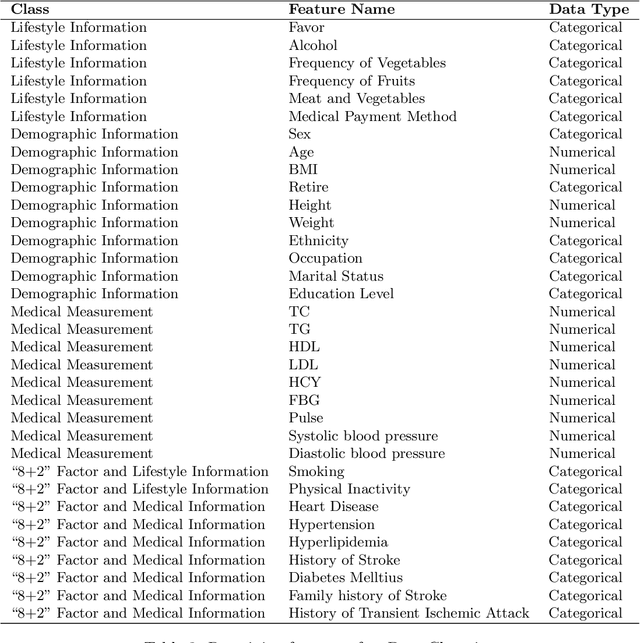

Abstract:In China, stroke is the first leading cause of death in recent years. It is a major cause of long-term physical and cognitive impairment, which bring great pressure on the National Public Health System. Evaluation of the risk of getting stroke is important for the prevention and treatment of stroke in China. A data set with 2000 hospitalized stroke patients in 2018 and 27583 residents during the year 2017 to 2020 is analyzed in this study. Due to data incompleteness, inconsistency, and non-structured formats, missing values in the raw data are filled with -1 as an abnormal class. With the cleaned features, three models on risk levels of getting stroke are built by using machine learning methods. The importance of "8+2" factors from China National Stroke Prevention Project (CSPP) is evaluated via decision tree and random forest models. Except for "8+2" factors the importance of features and SHAP1 values for lifestyle information, demographic information, and medical measurement are evaluated and ranked via a random forest model. Furthermore, a logistic regression model is applied to evaluate the probability of getting stroke for different risk levels. Based on the census data in both communities and hospitals from Shanxi Province, we investigate different risk factors of getting stroke and their ranking with interpretable machine learning models. The results show that Hypertension (Systolic blood pressure, Diastolic blood pressure), Physical Inactivity (Lack of sports), and Overweight (BMI) are ranked as the top three high-risk factors of getting stroke in Shanxi province. The probability of getting stroke for a person can also be predicted via our machine learning model.
Enriching Medcial Terminology Knowledge Bases via Pre-trained Language Model and Graph Convolutional Network
Sep 02, 2019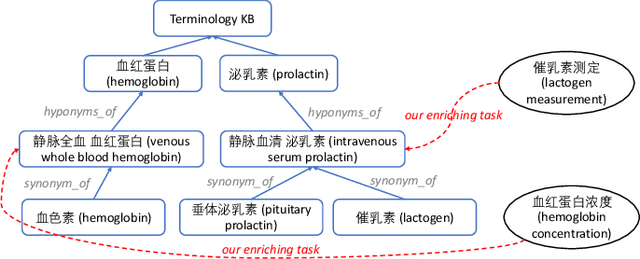
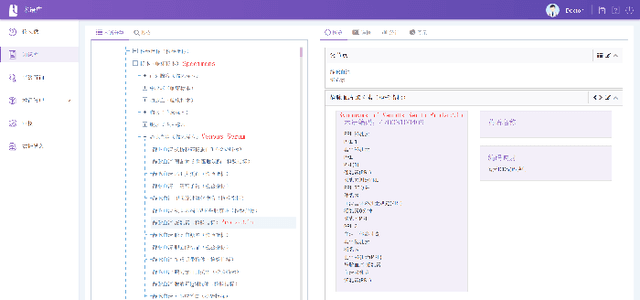
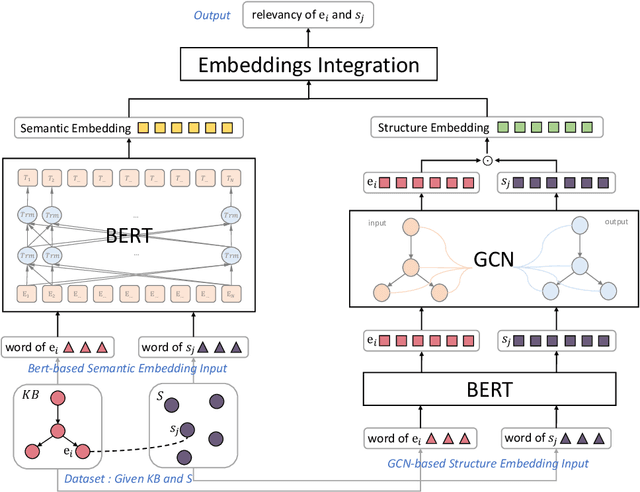
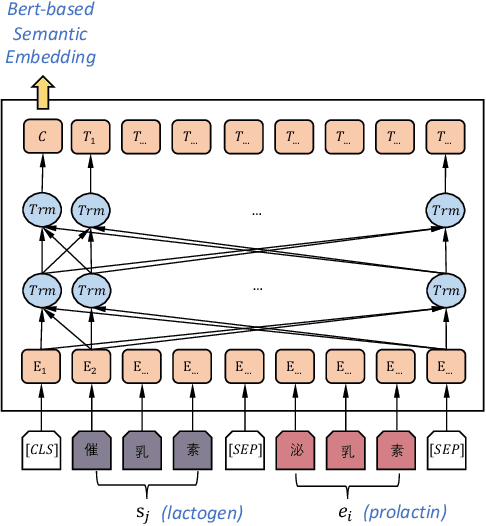
Abstract:Enriching existing medical terminology knowledge bases (KBs) is an important and never-ending work for clinical research because new terminology alias may be continually added and standard terminologies may be newly renamed. In this paper, we propose a novel automatic terminology enriching approach to supplement a set of terminologies to KBs. Specifically, terminology and entity characters are first fed into pre-trained language model to obtain semantic embedding. The pre-trained model is used again to initialize the terminology and entity representations, then they are further embedded through graph convolutional network to gain structure embedding. Afterwards, both semantic and structure embeddings are combined to measure the relevancy between the terminology and the entity. Finally, the optimal alignment is achieved based on the order of relevancy between the terminology and all the entities in the KB. Experimental results on clinical indicator terminology KB, collected from 38 top-class hospitals of Shanghai Hospital Development Center, show that our proposed approach outperforms baseline methods and can effectively enrich the KB.
Active Learning for Chinese Word Segmentation in Medical Text
Aug 22, 2019
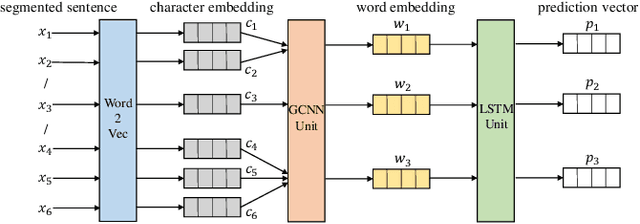
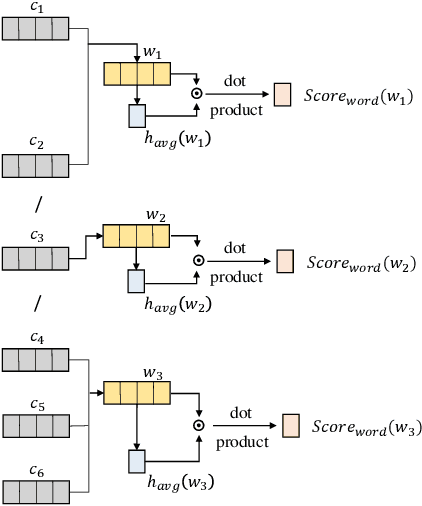

Abstract:Electronic health records (EHRs) stored in hospital information systems completely reflect the patients' diagnosis and treatment processes, which are essential to clinical data mining. Chinese word segmentation (CWS) is a fundamental and important task for Chinese natural language processing. Currently, most state-of-the-art CWS methods greatly depend on large-scale manually-annotated data, which is a very time-consuming and expensive work, specially for the annotation in medical field. In this paper, we present an active learning method for CWS in medical text. To effectively utilize complete segmentation history, a new scoring model in sampling strategy is proposed, which combines information entropy with neural network. Besides, to capture interactions between adjacent characters, K-means clustering features are additionally added in word segmenter. We experimentally evaluate our proposed CWS method in medical text, experimental results based on EHRs collected from the Shuguang Hospital Affiliated to Shanghai University of Traditional Chinese Medicine show that our proposed method outperforms other reference methods, which can effectively save the cost of manual annotation.
Fine-tuning BERT for Joint Entity and Relation Extraction in Chinese Medical Text
Aug 21, 2019



Abstract:Entity and relation extraction is the necessary step in structuring medical text. However, the feature extraction ability of the bidirectional long short term memory network in the existing model does not achieve the best effect. At the same time, the language model has achieved excellent results in more and more natural language processing tasks. In this paper, we present a focused attention model for the joint entity and relation extraction task. Our model integrates well-known BERT language model into joint learning through dynamic range attention mechanism, thus improving the feature representation ability of shared parameter layer. Experimental results on coronary angiography texts collected from Shuguang Hospital show that the F1-score of named entity recognition and relation classification tasks reach 96.89% and 88.51%, which are better than state-of-the-art methods 1.65% and 1.22%, respectively.
 Add to Chrome
Add to Chrome Add to Firefox
Add to Firefox Add to Edge
Add to Edge